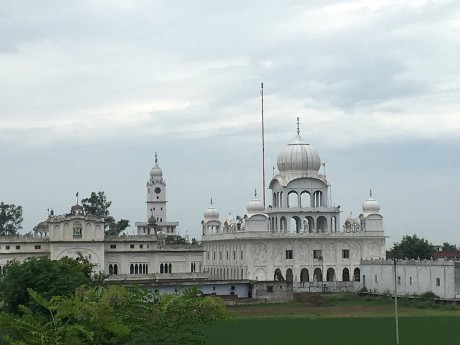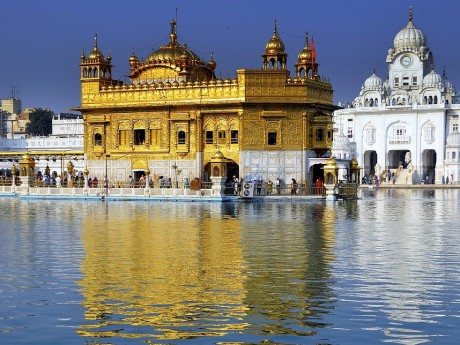India: Ludhiana & Amritsar
Begin your journey in Ludhiana, Punjab’s largest city and industrial powerhouse, where the bustling markets and rich traditions of Punjabi culture come alive. Explore the Punjab Agricultural University Museum, and shop for traditional textiles in the city's vibrant bazaars. Savor the local cuisine, renowned for its rich flavors and hearty dishes. Then, head to Amritsar, the spiritual heart of Punjab.
Read more
Begin your journey in Ludhiana, Punjab’s largest city and industrial powerhouse, where the bustling markets and rich traditions of Punjabi culture come alive. Explore the Punjab Agricultural University Museum, and shop for traditional textiles in the city's vibrant bazaars. Savor the local cuisine, renowned for its rich flavors and hearty dishes. Then, head to Amritsar, the spiritual heart of Punjab. Marvel at the Golden Temple, the holiest site in Sikhism, and partake in the Langar, which serves free meals to all visitors. Pay homage at Jallianwala Bagh, a poignant site in India's independence history, and witness the lively Wagah Border ceremony, a display of patriotism and pageantry. End your trip with a stroll through Amritsar’s bustling markets, soaking in the vibrant atmosphere and savoring local delicacies. Waterviews strives to offer accommodation options within walking distance of water and/or in an area of touristic interest. Our prices include taxes (but excludes local tourist taxes). Customize your trip to your personal preferences with optional activities (hit the “Add Activities’’) or change hotels, etc. Contact us for customization at no extra cost at: Service@waterviewstravel.com
Destinations
- Ludhiana
- Amritsar
Itinerary
Ludhiana

Ludhiana, the largest city in Punjab, India, is known as the "Manchester of India" for its thriving textile industry. Located on the Sutlej River, it is a major economic hub with a rich cultural heritage, vibrant markets, and renowned Punjabi cuisine.
Read more
Ludhiana is in Punjab in India.
Additional Information
Ludhiana is Punjab's most populated city. It's also an important industrial town. For its production of hosiery, Ludhiana is known as the Manchester of India. Its district is also one of the largest agricultural producers in India, particularly of grains. Established in 1960s, the Punjab Agricultural University is considered as one of the best agricultural universities in India. The city stands on the south bank of the Sutlej river. It was a major town on the Grand Trunk Road, one of Asia's oldest roads.
Climate
The best time to visit Ludhiana is from February to April. Nights can get quite cold during the winter (from November to January), falling to as low as 0 °C. May and June are very hot; summer temperatures in Ludhiana can reach 50 °C
© Sourced from Wikivoyage
Amritsar

Amritsar, a historic city in Punjab, India, is best known for the Golden Temple, the holiest shrine of Sikhism. It is a spiritual and cultural center, attracting millions of visitors for its sacred sites, vibrant bazaars, and rich culinary traditions.
Read more
Amritsar (ਅੰਮ੍ਰਿਤਸਰ) is a city in the state of Punjab, India. It is the holiest city in the Sikh religion.
Additional Information
The name Amritsar name derives from the pool around the Golden Temple (aka Harmandir Sahib) and means "holy pool of nectar" (Amrit elixir; Sar, short for sarovar which means "lake"). Amritsar is one of the largest cities in the Indian state of Punjab and is the spiritual and cultural centre of the Sikh religion. Sikhs are rightfully very proud of the city and their very beautiful and unique Gurdwara (place of worship), the Golden Temple. Amritsar is today a major pilgrimage centre for Sikhs and a tourism centre for anyone.
History
Amritsar is known mainly for its Golden Temple which was initiated by Guru Ram Das, the fourth Sikh Guru and the founder of the city, and completed in 1601 by his successor Guru Arjan Dev Ji.
The Jallianwala Bagh massacre or Amritsar massacre occurred in 1919. The area where this occurred was a large, open square but walled in on all sides. British troops opened fire on a crowd of demonstrators, and a large number were killed — the British said 370 dead and 1,200 wounded but Indian sources say the total was well over 1,000 dead. Some of the victims were, in fact, demonstrating, protesting against the arrest of two political activists, while others were gathered to celebrate the traditional festival of Baisakhi. Not all died directly due to British fire; many were trampled in the stampede to escape and others died diving down a well to avoid the bullets. Today the well is a rather grisly tourist attraction and bullet holes are still visible on walls around the area.
The massacre news spread quickly all over the country caused widespread outrage and additional demonstrations as it stunned the entire sub-continent. Eventually, the public lost faith in the British colonial government and subsequently, this massacre initiated the "Non-cooperation movement" led by the father of the nation, Mahatma Gandhi. It is considered a significant phase of the Indian independence movement from British rule.
It also had a tremendous effect in the UK, with many of the more liberal British appalled by it while others thought it necessary. A commission investigated and concluded that "General Dyer thought he had crushed the rebellion and Sir Michael O'Dwyer was of the same view, ... (but) there was no rebellion which required to be crushed." Dyer was in command on the spot and O'Dwyer the provincial governor.
During the partition of the Indian Subcontinent in 1947, the Punjab region was divided between India and Pakistan near Amritsar. Pakistan wanted to annexe Amritsar due to its close proximity with Lahore and 50% Muslim population; however, the city remained inside Indian territory. Similarly, India wanted to annexe Lahore. Both of the cities experienced some of the worst communal riots during the partition. Mass evacuations were made both in Amritsar and in Lahore. Hence, the demographics of both the cities were changed following the partition, significantly altering the culture and affecting the political, economic and social environment of the cities.In June 1984, an Indian military operation ordered by then Prime Minister of India, Indira Gandhi, was launched in the city to remove a few hundred Sikh militants who had taken control of the Golden Temple compound. After a few hundred people were killed during the 5-day siege, thousands of civilians were killed throughout the country in the aftermath.
© Sourced from Wikivoyage





